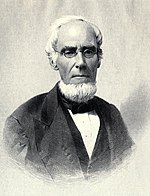Telegraph and Texas Register
Originally conceived as the Telegraph and Texas Planter, the newspaper was renamed shortly before it began publication, to reflect its new mission to be "a faithful register of passing events".
As the war for independence intensified, however, Thomas Borden and Joseph Baker joined as soldiers, and left Gail to run the paper alone.
[5] He was the secretary of the ayuntamiento of San Felipe de Austin, a community which had long been at the center of Texas politics, and he could read Spanish well.
[7] The advertisement also vowed that the new newspaper would "be ready to advocate such principles and measures as have a tendency to promote union between Texas and the Mexican Confederation, as well as to oppose everything tending to dissolve or weaken the connexion [sic] between them.
In an editorial, the owners explained that the paper's original name had been chosen when "the engrossing object was the accumulating of wealth and consequent aggrandizement of the country.
[6] As editor, Gail Borden strived to be somewhat objective, avoiding blatantly biased or partisan opinions unless a counterpart was also provided.
[13] The frequent public document printings caused the press to run low on newsprint, and by mid-December the Telegraph consisted of only four pages rather than eight.
[15] Historian Eugene C. Barker describes the paper as "an invaluable repository of public documents during this critical period of the state's history".
[9] Editorials in the newspaper often compared the fighting in Texas to the American Revolution, even publishing extracts from United States documents of that era.
[14] Borden received news directly from other military leaders, including Jim Bowie and James Fannin, and political heavyweights such as Sam Houston and Lorenzo de Zavala.
"[19] Borden further noted that "It has never been the objective of this paper to forestall public opinion and to crowd upon the people our own views in a matter so important as that touching a change in government.
[Note 1][12] Gail Borden, Jr and two other printers were drafted for the army on February 29 but were excused from service so that the press could continue to operate.
The competing publisher never formed, and Borden remained the official printer of the interim government, but at a disadvantage as he was 20 miles (32 km) from the proceedings.
The publishers of the Telegraph immediately offered their services to the interim government, pledging that they were "prepared to execute any order, either at night or day".
[Note 2] More prominently displayed was the letter To the People of Texas & All Americans in the World,[19] which Texian commander William B. Travis had written begging for reinforcements and supplies for his garrison at the Alamo.
By the following issue, the Telegraph was decisively for independence, praising Consultation delegates for their "unparalleled" speed, as "the alarming situation of our country admitted of no delay".
The original letter was misplaced or destroyed during the confusion, and the only record of it is from the newspaper edition and the thousand broadsheets the Bordens printed on order of the Convention.
[24] Borden refused to join the Runaway Scrape, asserting that "so long as a paper should be printed west of the Brazos, the people east of it would not take alarm.
[9] The Bordens successfully set up the press in Harrisburg, and on April 13 the Telegraph was named the official paper of the Republic of Texas.
[Note 3][15][27] The Texas Revolution ended one week later, when Santa Anna was captured following the Mexican defeat at the Battle of San Jacinto.
[19] The editorial concluded: "Notwithstanding so many embarrassments and difficulties, we announce to the citizens of Texas, that we are again prepared to do their printing, and are ready once more to defend the cause of our country.
It was very difficult to transport large loads overland, so publishers made arrangements to ship the printing press via boat.
Editors generally made little effort to gather and report news,[35] as the information would already be widely known by the time the paper was printed.
Articles emphasized the good character of recent settlers (as opposed to the widespread belief that residents of Texas were scoundrels) and the advantages of living in the country.
A Union blockade of the Gulf Coast made newsprint even scarcer,[35] and Cushing was forced to print the newspaper on wallpaper and wrapping paper.
After Union forces closed the Mississippi River, making transportation more difficult, Cushing relied on a pony express to gather and forward news from the battlefronts.
Many Texans, staunch Confederates who were still unhappy that they had lost the war, resented the advice, and the newspaper began to lose readership.
[30] Shortly after the newspaper launched, Borden set out his philosophy that "to render the press useful it should never be prostituted to misrepresentation, slander, and vituperation.
[44] At the same time, as early as 1837, the newspaper advocated annexation to the United States,[45] even publishing a series of articles explaining that Texas should have been considered part of the Louisiana Purchase.
[48] According to historian Andrea Kökény, the Telegraph was "an influential molder of public opinion", which "has become an essential source to the understanding of the early history of American Texas and the construction of the identity of the people who lived in it".



